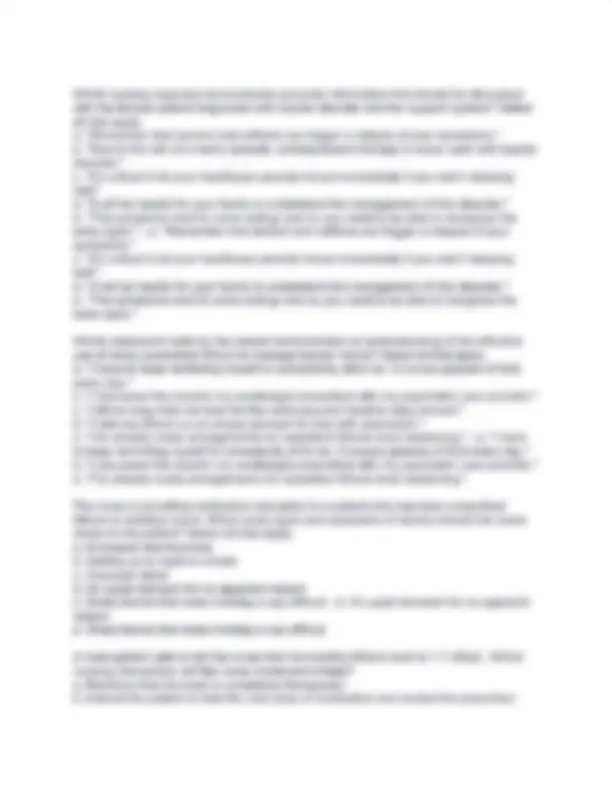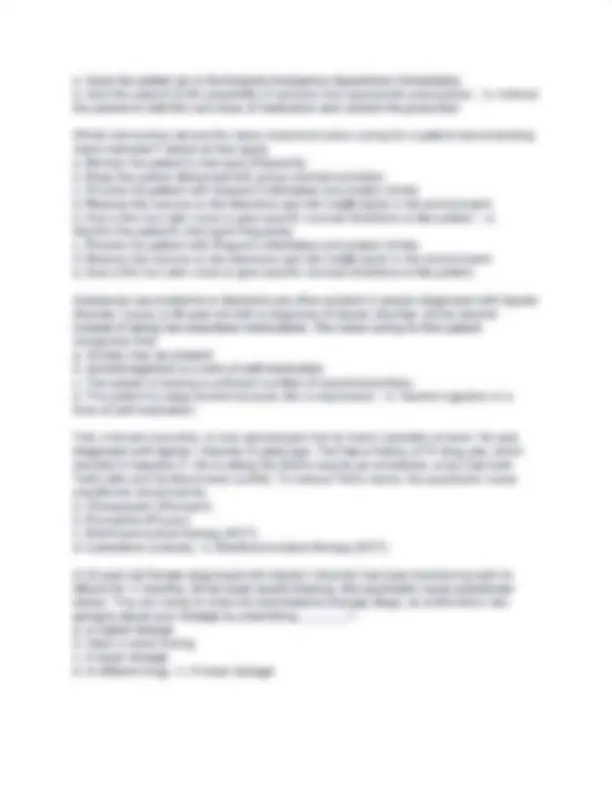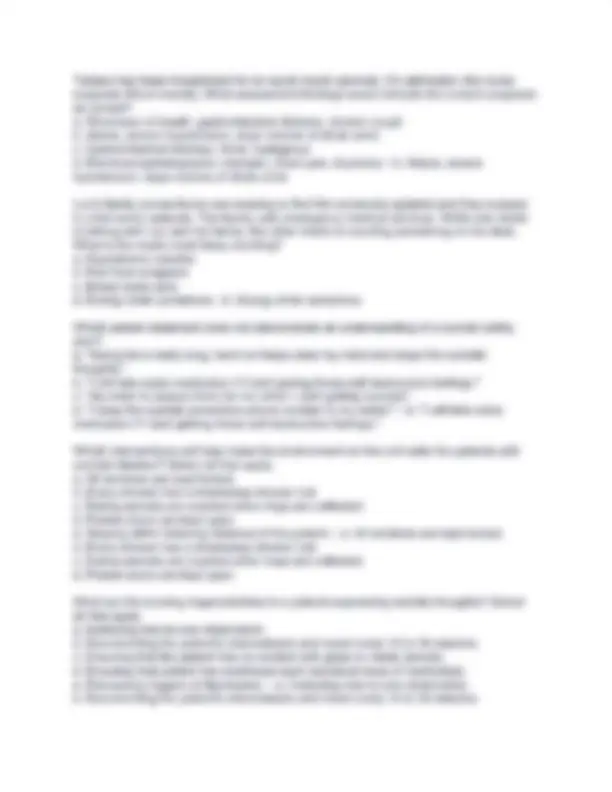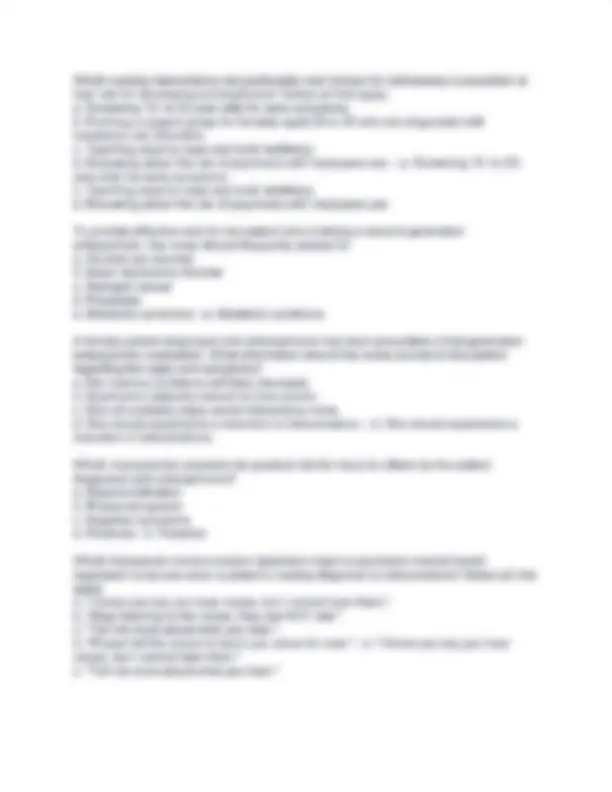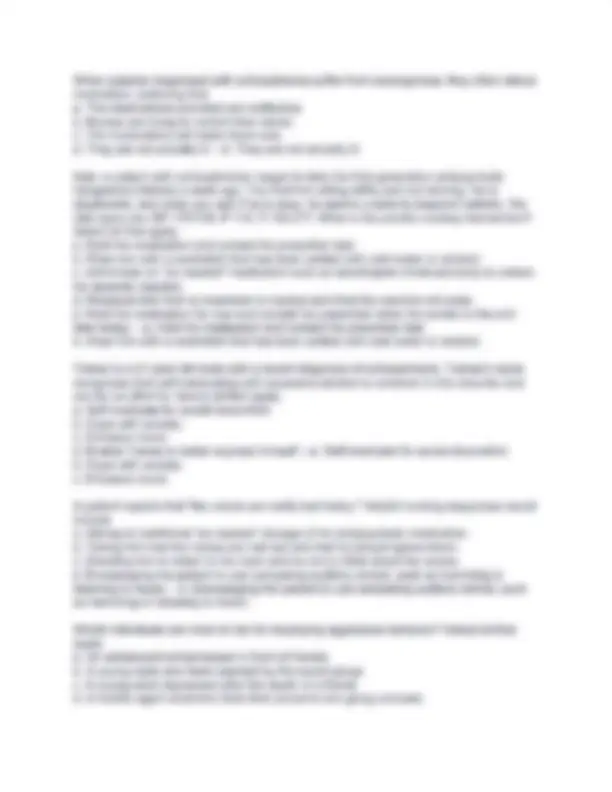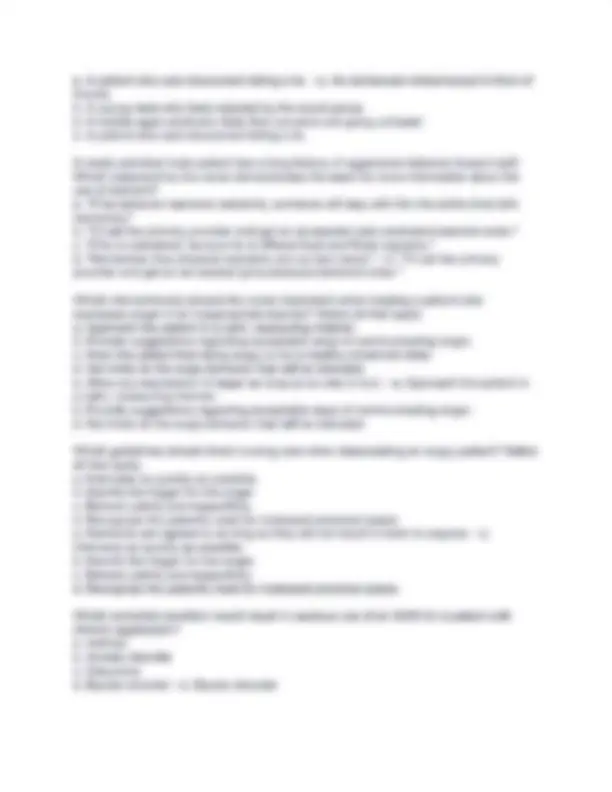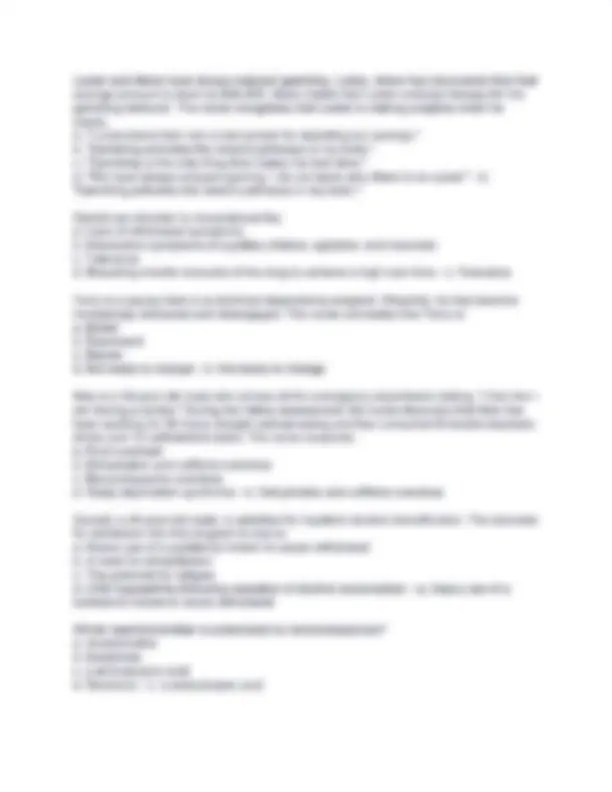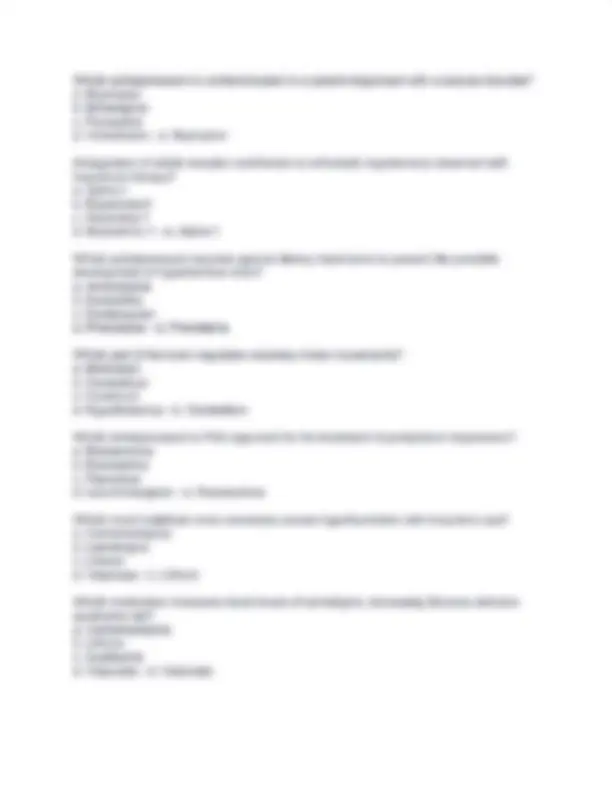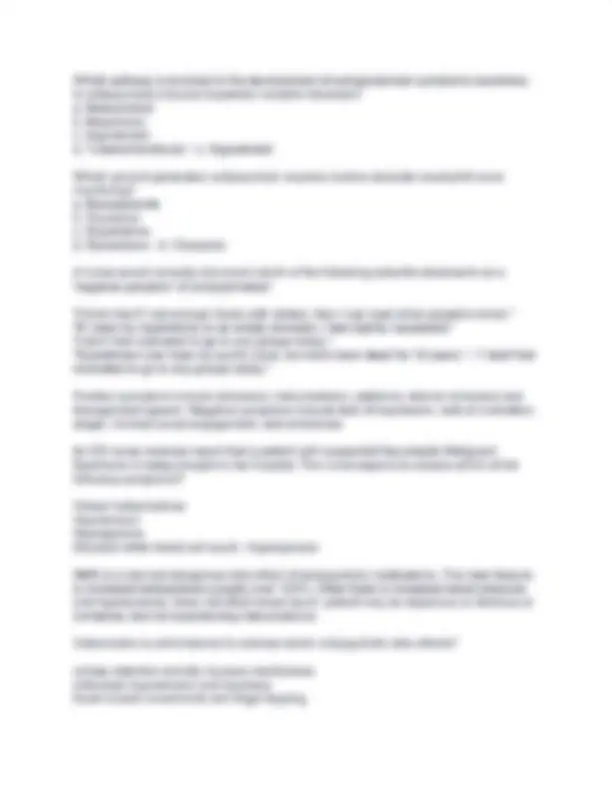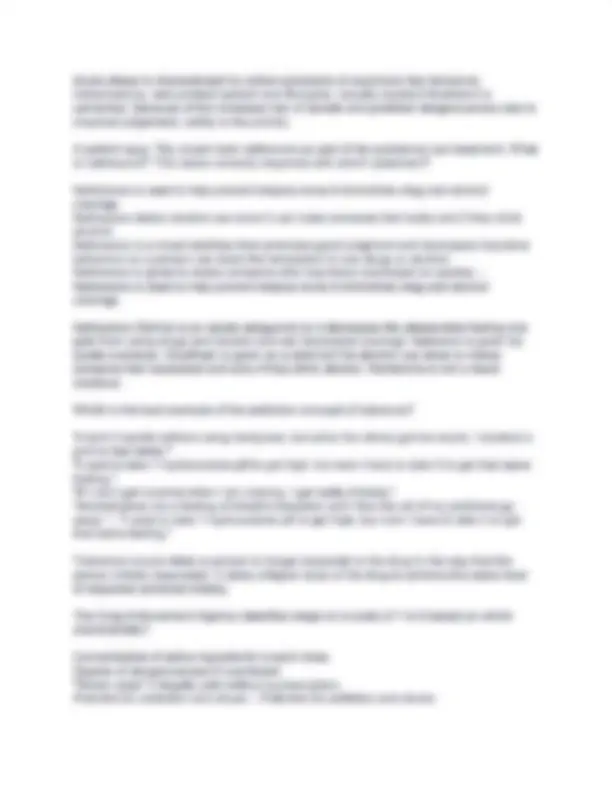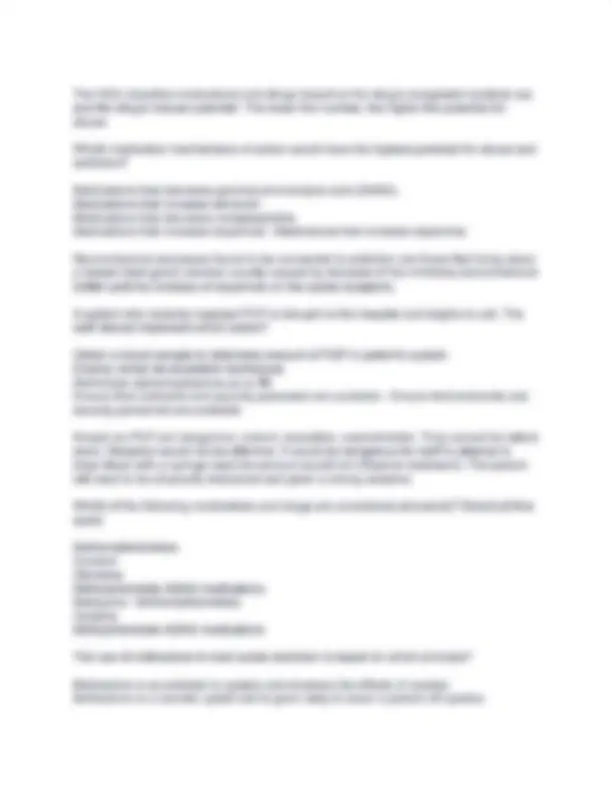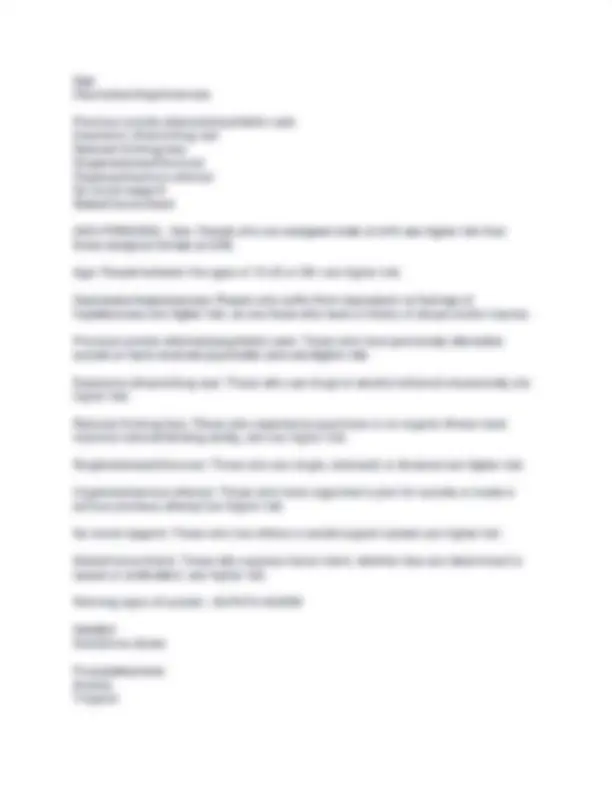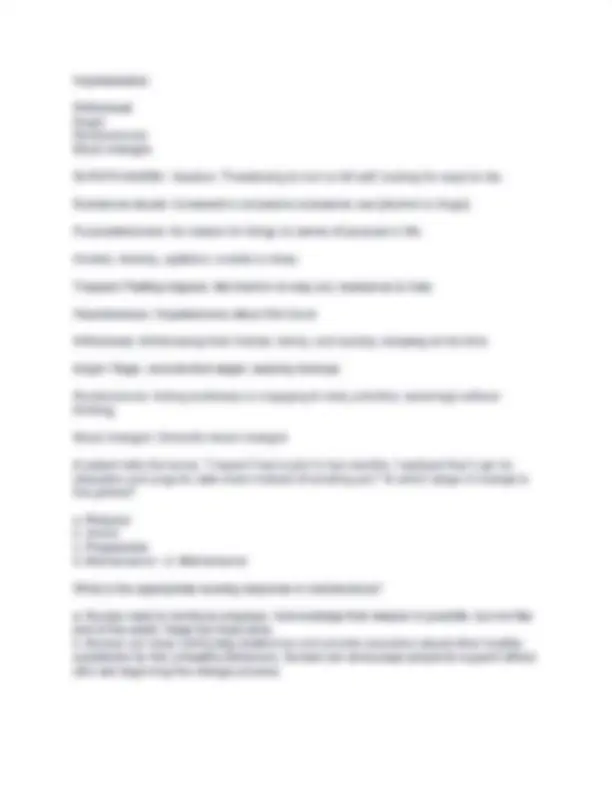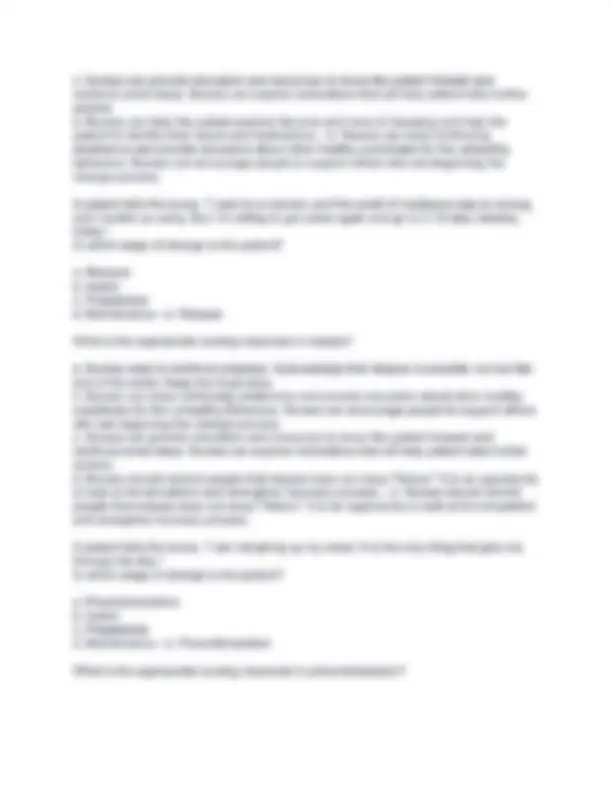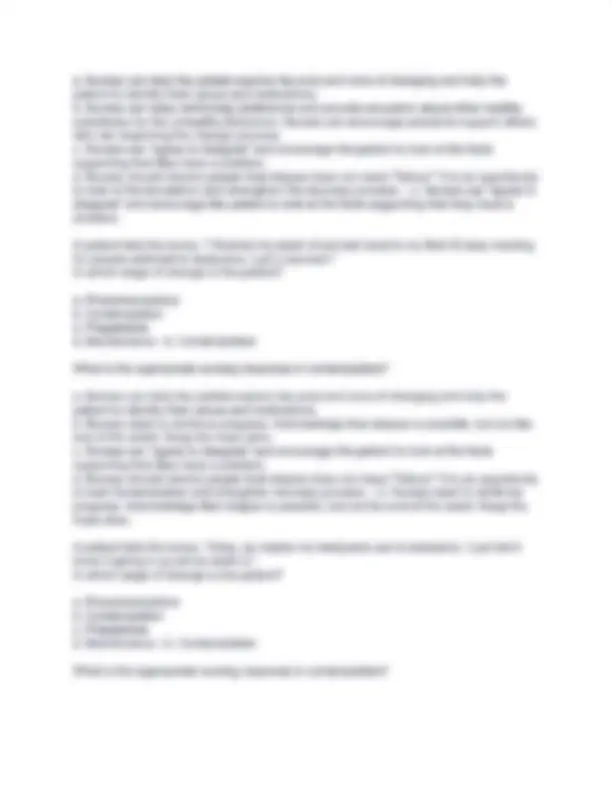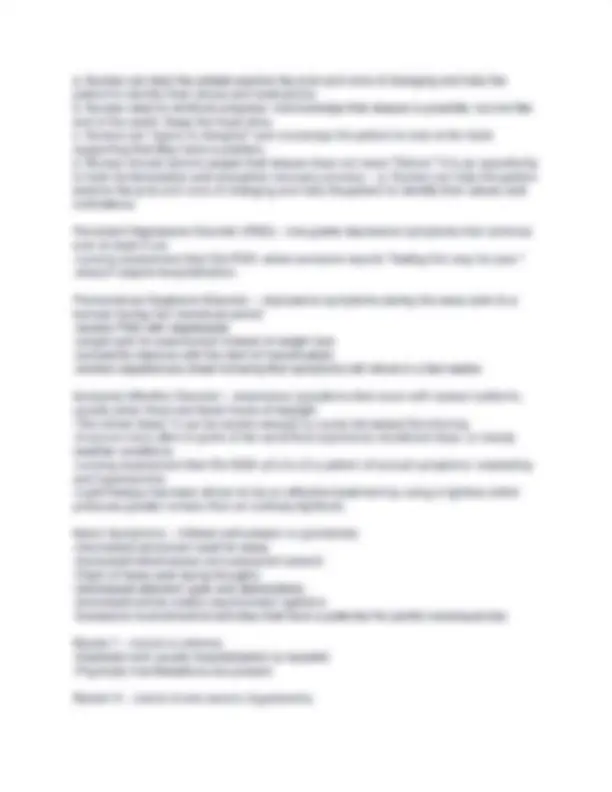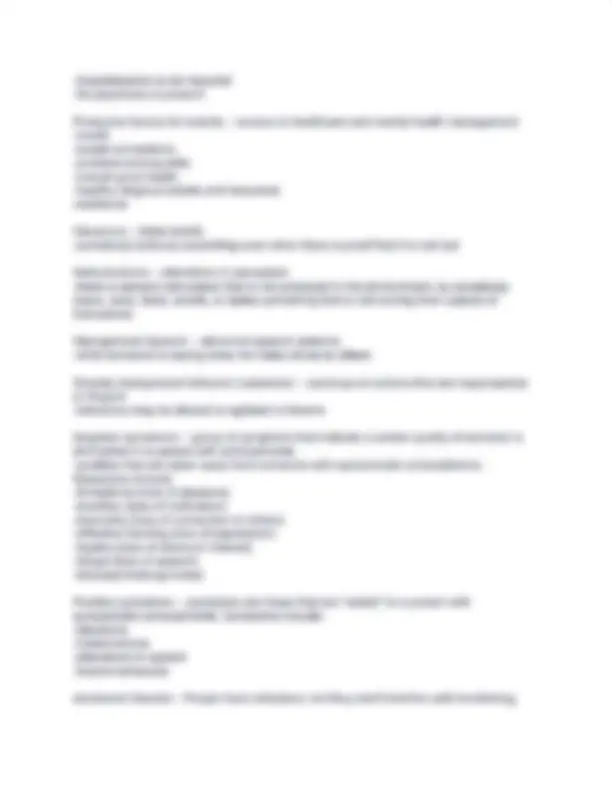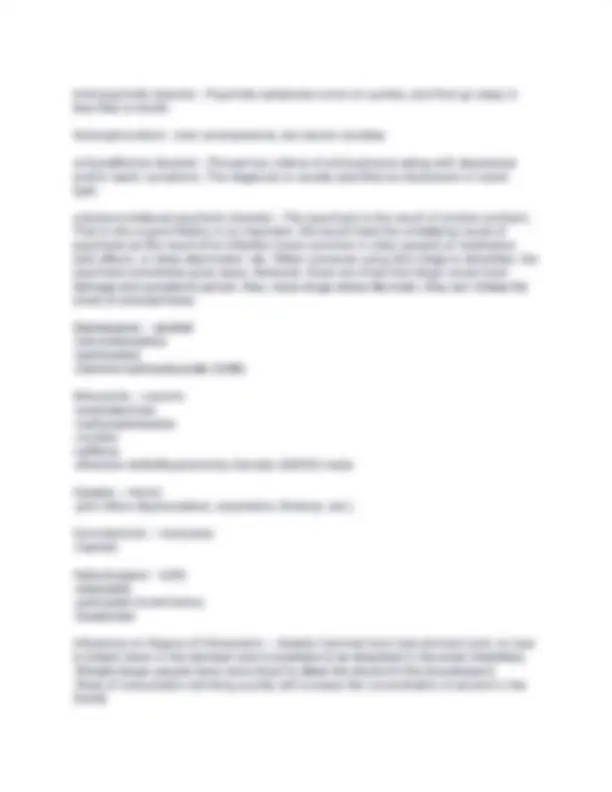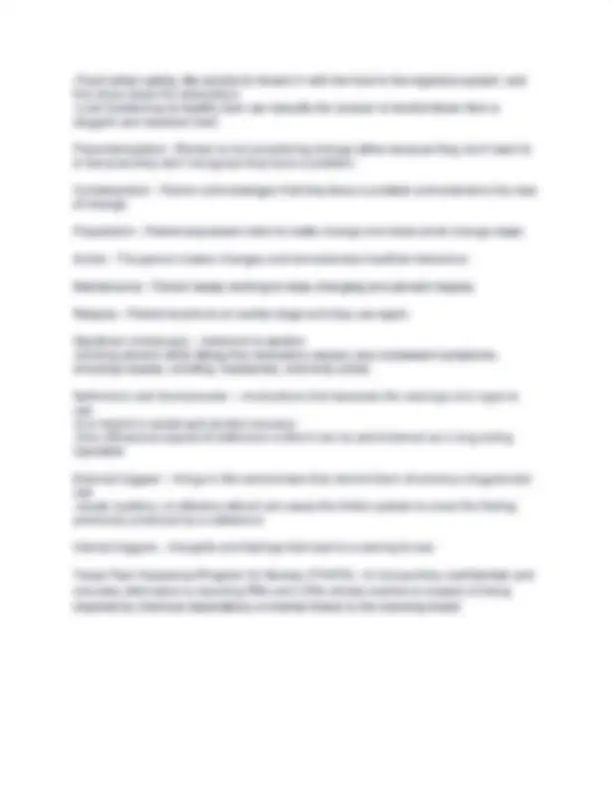Partial preview of the text
Download Mental Health Exam 2 Latest 2025 Update!!! Graded A+ and more Exams Nursing in PDF only on Docsity!
Which response by a 15-year-old demonstrates a common symptom observed in patients diagnosed with major depressive disorder? a. "I'm so restless. | can't seem to sit still." b. "I spend most of my time studying. | have to get into a good college." c. "I'm obsessed with counting telephone poles as | drive by them." d. "I go to sleep around 11 p.m. but I'm always up by 3 a.m. and can't go back to sleep." - d."I go to sleep around 11 p.m. but I'm always up by 3 a.m. and can't go back to sleep." Which assessment question asked by the nurse demonstrates an understanding of comorbid mental health conditions associated with major depressive disorder? Select all that apply. a. "Do rules apply to you?" b. "What do you do to manage anxiety?" c. "Do you have a history of disordered eating?" d. "Do you think that you drink too much?" e. "Have you ever been arrested for committing a crime?" - b. "What do you do to manage anxiety?" c. "Do you have a history of disordered eating?" d. "Do you think that you drink too much?" Which nursing intervention focuses on managing a common characteristic of major depressive disorder associated with the older population? a. Conducting routine suicide screenings at a senior center. b. Identifying depression as a natural, but treatable result of aging. c. Identifying males as being at a greater risk for developing depression. d. Stressing that most individuals experience just a single episode of major depressive disorder in a lifetime. - a. Conducting routine suicide screenings at a senior center. Which characteristic identified during an assessment serves to support a diagnosis of disruptive mood dysregulation disorder? Select all that apply. . Female b. 7 years old c. Comorbid autism diagnosis d. Outbursts occur at least once a week e c e » . Temper tantrums occur at home and in school - b. 7 years old . Comorbid autism diagnosis . Temper tantrums occur at home and in school Which chronic medical condition is a common trigger for major depressive disorder? a. Pain b. Hypertension c. Hypothyroidism d. Crohn disease - a. Pain Tammy, a 28-year-old with major depressive disorder and bulimia nervosa, is ready for discharge from the county hospital after 2 weeks of inpatient therapy. Tammy is taking citalopram (Celexa) and reports that it has made her feel more hopeful. With a secondary diagnosis of bulimia nervosa, what is an alternative antidepressant to consider? a. Fluoxetine (Prozac) b. Isocarboxazid (Marplan) c. Amitriptyline d. Duloxetine (Cymbalta) - a. Fluoxetine (Prozac) Cabot has multiple symptoms of depression, including mood reactivity, social phobia, anxiety, and overeating. With a history of mild hypertension, which classification of antidepressants dispensed as a transdermal patch would be a safe medication? a. Tricyclic antidepressants b. Selective serotonin reuptake inhibitors c. Serotonin and norepinephrine reuptake inhibitors d. Monoamine oxidase inhibitor - d. Monoamine oxidase inhibitor When a nurse uses therapeutic communication with a withdrawn patient who has major depressive disorder, an effective method of managing the silence is to: a. Meditate in the quiet environment b. Ask simple questions even if the patient will not answer c. Use the technique of making observations d. Simply sit quietly and leave when the patient falls asleep - c. Use the technique of making observations The biological approach to treating depression with electrodes surgically implanted into specific areas of the brain to stimulate the regions identified to be underactive in depression is: a. Transcranial magnetic stimulation b. Deep brain stimulation c. Vagus nerve stimulation d. Electroconvulsive therapy - b. Deep brain stimulation Two months ago, Natasha's husband died suddenly and she has been overwhelmed with grief. When Natasha is subsequently diagnosed with major depressive disorder, her daughter, Nadia, makes which true statement? a. "Depression often begins after a major loss. Losing dad was a major loss." b. "Bereavement and depression are the same problem." c. "Mourning is pathological and not normal behavior." d. "Antidepressant medications will not help this type of depression." - a. "Depression often begins after a major loss. Losing dad was a major loss." c. Have the patient go to the hospital emergency department immediately. d. Alert the patient to the possibility of seizures and appropriate precautions. - b. Instruct the patient to hold the next dose of medication and contact the prescriber. Which intervention should the nurse implement when caring for a patient demonstrating manic behavior? Select all that apply. a. Monitor the patient's vital signs frequently. b. Keep the patient distracted with group-oriented activities. c. Provide the patient with frequent milkshakes and protein drinks. d. Reduce the volume on the television and dim bright lights in the environment. e. Use a firm but calm voice to give specific concise directions to the patient. - a Monitor the patient's vital signs frequently. c. Provide the patient with frequent milkshakes and protein drinks. d. Reduce the volume on the television and dim bright lights in the environment. e. Use a firm but calm voice to give specific concise directions to the patient. Substance use problems or disorders are often present in people diagnosed with bipolar disorder. Laura, a 28-year-old with a diagnosis of bipolar disorder, drinks alcohol instead of taking her prescribed medications. The nurse caring for this patient recognizes that: a. Anxiety may be present. b. Alcohol ingestion is a form of self-medication. c. The patient is lacking a sufficient number of neurotransmitters. d. The patient is using alcohol because she is depressed. - b. Alcohol ingestion is a form of self-medication. Ted, a former executive, is now unemployed due to manic episodes at work. He was diagnosed with bipolar | disorder 8 years ago. Ted has a history of IV drug use, which resulted in hepatitis C. He is taking his lithium exactly as scheduled, a fact that both Ted's wife and his blood tests confirm. To reduce Ted's mania, the psychiatric nurse practitioner recommends: a. Clonazepam (Klonopin) b. Fluoxetine (Prozac) c. Electroconvulsive therapy (ECT) d. Lurasidone (Latuda) - c. Electroconvulsive therapy (ECT) A 33-year-old female diagnosed with bipolar | disorder has been functioning well on lithium for 11 months. At her most recent checkup, the psychiatric nurse practitioner states, "You are ready to enter the maintenance therapy stage, so at this time | am going to adjust your dosage by prescribing a. A higher dosage b. Once a week dosing c. A lower dosage d. A different drug - c. A lower dosage Tatiana has been hospitalized for an acute manic episode. On admission, the nurse suspects lithium toxicity. What assessment findings would indicate the nurse's suspicion as correct? a. Shortness of breath, gastrointestinal distress, chronic cough b. Ataxia, severe hypotension, large volume of dilute urine c. Gastrointestinal distress, thirst, nystagmus d. Electroencephalographic changes, chest pain, dizziness - b. Ataxia, severe hypotension, large volume of dilute urine Luc's family comes home one evening to find him extremely agitated and they suspect in a full manic episode. The family calls emergency medical services. While one medic is talking with Luc and his family, the other medic is counting something on his desk. What is the medic most likely counting? a. Hypodermic needles b. Fast food wrappers c. Empty soda cans d. Energy drink containers - d. Energy drink containers Which patient statement does not demonstrate an understanding of a suicide safety plan? a. "Going for a really long, hard run helps clear my mind and stops the suicidal thoughts." b. "I will take extra medication if | start getting those self-destructive feelings.” c. "My sister is always there for me when | start getting suicidal." d. "| keep the suicide prevention phone number in my wallet." - b. "! will take extra medication if | start getting those self-destructive feelings." Which interventions will help make the environment on the unit safer for patients with suicidal ideation? Select all that apply. . All windows are kept locked. . Every shower has a breakaway shower rod. . Eating utensils are counted when trays are collected. . Patient doors are kept open. . Staying within listening distance of the patient. - a. All windows are kept locked. . Every shower has a breakaway shower rod. . Eating utensils are counted when trays are collected. . Patient doors are kept open. eaQo7nng0T7D What are the nursing responsibilities to a patient expressing suicidal thoughts? Select all that apply. . Instituting one-to-one observation. . Documenting the patient's whereabouts and mood every 15 to 30 minutes. . Ensuring that the patient has no contact with glass or metal utensils. . Ensuring that patient has swallowed each individual dose of medication. . Discussing triggers of depression. - a. Instituting one-to-one observation. . Documenting the patient's whereabouts and mood every 15 to 30 minutes. TOoOaQ07M Which person is at the highest risk for suicide? a. A 50-year-old married white male with major depressive disorder who has a plan to overdose if circumstances at work do not improve. b. A 45-year-old married white female who recently lost her parents, suffers from bipolar disorder, and attempted suicide once as a teenager. c. A young single white male who misuses alcohol, is hopeless, impulsive, has just been rejected by his girlfriend, and has ready access to a gun he has hidden. d. An older Hispanic male who is Catholic, living with a debilitating chronic illness, recently widowed, and who states, "| wish that God would take me too." - c. A young single white male who misuses alcohol, is hopeless, impulsive, has just been rejected by his girlfriend, and has ready access to a gun he has hidden. Kara is a 23-year-old patient admitted with major depressive disorder and suicidal ideation. Which intervention(s) would be therapeutic for Kara? Select all that apply. a. Focus primarily on developing solutions to the problems that lead the patient to feel suicidal. b. Assess the patient thoroughly and reassess the patient at regular intervals as levels of risk fluctuate. c. Avoid talking about the suicidal ideation as this may increase the patient's risk for suicidal behavior. d. Meet regularly with the patient to provide opportunities for the patient to express and explore feelings. e. Administer antidepressant medications cautiously and conservatively because of their potential to increase the suicide risk in Kara's age group. f. Help the patient to identify positive self-attributes and to question negative self- perceptions that are unrealistic. - b. Assess the patient thoroughly and reassess the patient at regular intervals as levels of risk fluctuate. d. Meet regularly with the patient to provide opportunities for the patient to express and explore feelings. e. Administer antidepressant medications cautiously and conservatively because of their potential to increase the suicide risk in Kara's age group. f. Help the patient to identify positive self-attributes and to question negative self- perceptions that are unrealistic. Which characteristics suggest a man is experiencing the prodromal phase of schizophrenia? Select all that apply. a. Always afraid that others will steal his belongings. b. Displays unusual interest in numbers and specific topics. c. Has increasingly unusual thoughts and uses words oddly. d. Demonstrates increasing difficulty with concentration. - a. Always afraid that others will steal his belongings. b. Displays unusual interest in numbers and specific topics. c. Has increasingly unusual thoughts and uses words oddly. d. Demonstrates increasing difficulty with concentration. Which nursing interventions are particularly well chosen for addressing a population at high risk for developing schizophrenia? Select all that apply. a. Screening 15- to 25-year-olds for early symptoms. b. Forming a support group for females aged 25 to 35 who are diagnosed with substance use disorders. c. Teaching ways to cope and build resiliency. d. Educating about the risk of psychosis with marijuana use. - a. Screening 15- to 25- year-olds for early symptoms. c. Teaching ways to cope and build resiliency. d. Educating about the risk of psychosis with marijuana use. To provide effective care for the patient who is taking a second-generation antipsychotic, the nurse should frequently assess for a. Alcohol use disorder b. Major depressive disorder c. Stomach cancer d. Polydipsia e. Metabolic syndrome - e. Metabolic syndrome A female patient diagnosed with schizophrenia has been prescribed a first-generation antipsychotic medication. What information should the nurse provide to the patient regarding her signs and symptoms? a. Her memory problems will likely decrease. b. Depressive episodes should be less severe. c. She will probably enjoy social interactions more. d. She should experience a reduction in hallucinations. - d. She should experience a reduction in hallucinations. Which characteristic presents the greatest risk for injury to others by the patient diagnosed with schizophrenia? a. Depersonalization b. Pressured speech c. Negative symptoms d. Paranoia - d. Paranoia Which therapeutic communication statement might a psychiatric-mental health registered nurse use when a patient's nursing diagnosis is hallucinations? Select all that apply. a. "| know you say you hear voices, but | cannot hear them." b. "Stop listening to the voices, they are NOT real." c. "Tell me more about what you hear." d. "Please tell the voices to leave you alone for now." - a. "| know you say you hear voices, but | cannot hear them." c. "Tell me more about what you hear." e. A patient who was discovered telling a lie. - a. An adolescent embarrassed in front of friends. b. A young male who feels rejected by the social group. d. A middle-aged adult who feels that concerns are going unheard. e. A patient who was discovered telling a lie. A newly admitted male patient has a long history of aggressive behavior toward staff. Which statement by the nurse demonstrates the need for more information about the use of restraint? a. "If his behavior warrants restraints, someone will stay with him the entire time he's restrained." b. "I'll call the primary provider and get an as-needed (prn) seclusion/restraint order." c. "If he is restrained, be sure he is offered food and fluids regularly." d. "Remember that physical restraints are our last resort." - b. "I'll call the primary provider and get an as-needed (prn) seclusion/restraint order." Which intervention(s) should the nurse implement when helping a patient who expresses anger in an inappropriate manner? Select all that apply. a. Approach the patient in a calm, reassuring manner. b. Provide suggestions regarding acceptable ways of communicating anger. c. Warn the patient that being angry is not a healthy emotional state. d. Set limits on the angry behavior that will be tolerated. e. Allow any expression of anger as long as no one is hurt. - a. Approach the patient in a calm, reassuring manner. b. Provide suggestions regarding acceptable ways of communicating anger. d. Set limits on the angry behavior that will be tolerated. Which guidelines should direct nursing care when deescalating an angry patient? Select all that apply. a. Intervene as quickly as possible. b. Identify the trigger for the anger. c. Behave calmly and respectfully. d. Recognize the patient's need for increased personal space. e. Demands are agreed to as long as they will not result in harm to anyone. - a. Intervene as quickly as possible. b. Identify the trigger for the anger. c. Behave calmly and respectfully. d. Recognize the patient's need for increased personal space. Which comorbid condition would result in cautious use of an SSRI for a patient with chronic aggression? a. Asthma b. Anxiety disorder c. Glaucoma d. Bipolar disorder - d. Bipolar disorder Patrick is a widower with four daughters. He enjoyed a healthy relationship with each of them until they reached puberty. As the girls began to mature physically, he acted in an aggressive manner, often beating them without provocation. Patrick is most likely acting on: a. Self-protective measures b. Stress of raising four daughters c. Frustration of unhealthy desire d. Motivating his daughters to be chaste - c. Frustration of unhealthy desire A nurse named Darryl has been hired to work in a psychiatric intensive care unit. He has undergone training on recognizing escalating anger. Which statement indicates that he understands danger signs in regard to aggression? a. "| need to be aware of patients who are withdrawn and sitting alone." b. "An abvious change in behavior is a risk factor for aggression." c. "Patients who seek constant attention are more likely to be violent." d. "Patients who talk to themselves are the most dangerous." - b. "An obvious change in behavior is a risk factor for aggression." An effective method of preventing escalation in an environment with violent offenders is to develop a level of trust through: a. A casual authoritative demeanor b. Keeping patients busy c. Brief, frequent, nonthreatening encounters d. Threats of seclusion or punishment - c. Brief, frequent, nonthreatening encounters A 24-hour observation is a good choice for restraint in which of the following patients? a. An inmate with suicidal ideation on hospice care b. A sex offender in the psychiatric intensive care unit c. An aggressive female with antisocial personality disorder d. An inmate diagnosed with paranoid schizophrenia - a. An inmate with suicidal ideation on hospice care Chronic obstructive pulmonary disease, spinal injury, seizure disorder, and pregnancy are conditions that: a. Frequently result in out of contro! behavior. b. Respond well to therapeutic holding. c. Necessitate the use of only two-point restraint. d. Contraindicate restraint and seclusion. - d. Contraindicate restraint and seclusion. Natalya, a patient with a history of alcohol use disorder, has been prescribed disulfiram (Antabuse). Which physical effects support the suspicion that the patient has relapsed? Select all that apply. a. Intense nausea b. Diaphoresis c. Acute paranoia d. Confusion Lester and Alene have always enjoyed gambling. Lately, Alene has discovered that their savings account is down by $50,000. Alene insists that Lester undergo therapy for his gambling behavior. The nurse recognizes that Lester is making progress when he states: a. "| understand that | am a bad person for depleting our savings." b. "Gambling activates the reward pathways in my brain." c. "Gambling is the only thing that makes me feel alive." d. "We have always enjoyed gaming. | do not know why Alene is so upset." - b. "Gambling activates the reward pathways in my brain." Opioid use disorder is characterized by: a. Lack of withdrawal symptoms b. Intoxication symptoms of pupillary dilation, agitation, and insomnia c. Tolerance d. Requiring smaller amounts of the drug to achieve a high over time - c. Tolerance Terry is a young male in a chemical dependency program. Recently, he has become increasingly distracted and disengaged. The nurse concludes that Terry is: a. Bored b. Depressed c. Bipolar d. Not ready to change - d. Not ready to change Max is a 30-year-old male who arrives at the emergency department stating, "I feel like | am having a stroke." During the intake assessment, the nurse discovers that Max has been working for 36 hours straight without eating and has consumed 8 double espresso drinks and 12 caffeinated sodas. The nurse suspects: a. Fluid overload b. Dehydration and caffeine overdose c. Benzodiazepine overdose d. Sleep deprivation syndrome - b. Dehydration and caffeine overdose Donald, a 49-year-old male, is admitted for inpatient alcohol detoxification. The rationale for admission into this program is due to: a. Heavy use of a substance known to cause withdrawal b. A need for rehabilitation c. The potential for relapse d. CNS hypoactivity following cessation of alcohol consumption - a. Heavy use of a substance known to cause withdrawal Which neurotransmitter is potentiated by benzodiazepines? a. Acetylcholine b. Dopamine c. y-aminobutyric acid d. Serotonin - c. y-aminobutyric acid Which antidepressant is contraindicated in a patient diagnosed with a seizure disorder? a. Bupropion b. Mirtazapine c. Paroxetine d. Venlafaxine - a. Bupropion Antagonism of which receptor contributes to orthostatic hypotension observed with trazodone therapy? a. Alpha-1 b. Dopamine-2 c. Histamine-1 d. Muscarinic-1 - a. Alpha-1 Which antidepressant requires special dietary restrictions to prevent the possible development of hypertensive crisis? a. Amitriptyline b. Duloxetine c. Escitalopram d. Phenelzine - d. Phenelzine Which part of the brain regulates voluntary motor movements? a. Brainstem b. Cerebellum c. Cerebrum d. Hypothalamus - b. Cerebellum Which antidepressant is FDA approved for the treatment of postpartum depression? a. Brexanolone b. Esketamine c. Fluoxetine d. Levomilnacipran - a. Brexanolone Which mood stabilizer most commonly causes hypothyroidism with long-term use? a. Carbamazepine b. Lamotrigine c. Lithium d. Valproate - c. Lithium Which medication increases blood levels of lamotrigine, increasing Stevens-Johnson syndrome risk? a. Carbamazepine b. Lithium c. Quetiapine d. Valproate - d. Valproate daytime sleepiness and night terrors - facial muscle movements and finger tapping Valbenazine (Ingrezza) was recently approved by the FDA to address symptoms of tardive dyskinesia, a side effect of long-term use of antipsychotic medications. Tardive dyskinesia is characterized by involuntary rhythmic movements such as lip smacking, grimacing, excessive blinking, neck gyrations, finger and foot tapping. A husband visiting his wife on an inpatient psychiatric unit says to the nurse, "| need to tell my wife that | want a divorce. Should | tell her while she's here?" Based on the Ethical principle of Veracity, the nurse says, "Yes, she has the right to know and make her own choices." "No, that would cause her emotional harm." "Why don't you tell her tomorrow. | don't have the time to console her today." "Yes, | believe that honesty is the best policy." - "Yes, | believe that honesty is the best policy." Veracity is the principle of truth telling. In order for a person to make fully rational choices, he or she must have the information relevant to his or her decision. Therefore, "Yes, | believe that honesty is the best policy." is the correct answer. the other options apply the principles of nonmaleficence, autonomy, and egoism. Which symptom indicates that a patient with schizophrenia is experiencing impaired executive functioning? Prefers to be alone and feels anxious when in a group setting Is mute Is unable to identify steps in obtaining subsidized housing benefits Is unable to sleep more than 4 hours due to nightmares - Is unable to identify steps in obtaining subsidized housing benefits Impaired executive functioning is a cognitive symptom sometimes seen with those with symptomatic schizophrenia. It includes difficulty with reasoning, placing events in chronological order, problem-solving, and considering cause and effect factors to a problem. Which of the following are considered second-generation antipsychotics? Paroxetine Ziprasidone Aripriprizole Clozapine Chlorpromazine - Ziprasidone Aripriprizole Clozapine Paroxetine is an SSRI. Chlorpromazine Is a first-generation anti-psychotic Why would an Abnormal Involuntary Movement Scale (AIMS) assessment be done before a patient begins a medication regimen? To obtain third party funding to cover the cost of medications.. To identify the effectiveness of medications in reducing positive symptoms of schizophrenia. To determine if a patient will be likely to adhere to the medication regimen. To identify if the patient demonstrates blinking and lip smacking prior to beginning medication. - To identify if the patient demonstrates blinking and lip smacking prior to beginning medication. The AIMS test is used to determine a baseline of symptoms that may appear similar to those of tardive dyskinesia such as facial movements, choreic movements in the hands, neck and trunk gyrations, and foot tapping. A nurse realizes that a patient who had been committed to the hospital two weeks ago has escaped. The healthcare team should No further action is needed since the patient received 2 weeks of treatment. Notify local homeless shelters. Notify the police. Discharge the patient AMA (against medical advice). - Notify the police. Since the patient was receiving court-ordered treatment, the police should be notified. A nurse will need to assess for which of the following conditions due to their high rates of co-morbidity with schizophrenia? Select all that apply Risk for Suicide Food allergies Polydipsia Decreased hearing acuity Cigarette smoking complications - Risk for Suicide Polydipsia Cigarette smoking complications The primary goal for someone in an acute phase of schizophrenia is which of the following: Clear communication with family members Improved self-esteem Safety from self-injury Development of vocational skills - Safety from self-injury The DEA classifies medications and drugs based on the drug's acceptable medical use and the drug's misuse potential. The lower the number, the higher the potential for abuse. Which medication mechanisms of action would have the highest potential for abuse and addiction? Medications that decrease gamma-aminobutyric acid (GABA) Medications that increase serotonin Medications that decrease norepinephrine Medications that increase dopamine - Medications that increase dopamine Neurochemical processes found to be connected to addiction are those that bring about a reward (feel good) reaction usually caused by increase of the inhibitory neurochemical GABA and the increase of dopamine on the opiate receptors. A patient who recently ingested PCP is brought to the hospital and begins to yell. The staff should implement which action? Obtain a blood sample to determine amount of PCP in patient's system Employ verbal de-escalation techniques Administer diphenhydramine po or IM Ensure that restraints and security personnel are available - Ensure that restraints and security personnel are available People on PCP are dangerous: violent, assaultive, unpredictable. They cannot be talked down. Benadryl would not be effective. It would be dangerous for staff to attempt to draw blood with a syringe (and the amount would not influence treatment). The person will need to be physically restrained and given a strong sedative. Which of the following medications and drugs are considered stimulants? Select all that apply: Methamphetamines Cocaine Clonidine Methylphenidate ADHD medications Marijuana - Methamphetamines Cocaine Methylphenidate ADHD medications The use of methadone to treat opiate addiction is based on which principle? Methadone is an antidote to opiates and reverses the effects of opiates. Methadone is a narcotic opioid and is given daily to wean a person off opiates. Methadone is a mild stimulant that counterbalances the sedating effects of opiates. Methadone is a nutrition supplement that replaces nutrients lost from opiate addiction. - Methadone is a narcotic opioid and is given daily to wean a person off opiates. Methadone is a synthetic narcotic opioid used to decrease painful symptoms of opiate withdrawal and will eventually need to be withdrawn due to dependence. Who is at highest risk for experiencing delirium tremens (DT's)? The person who is a heavy daily drinker and whose last drink was 24 hours ago. The person who binge drinks and whose last drink was 1 hour ago The person who drank every day for 1 year and whose last drink was 1 week ago The person who drank alcohol for the first time, passed out, and woke up 6 hours ago. - The person who is a heavy daily drinker and whose last drink was 24 hours ago. DT's occurs in severe alcohol withdrawals. The alcohol is out of their system and they have not had anything to drink in the last 72 hours. Their body has developed a tolerance to the alcohol. What is the therapeutic principle of helping patients to identify their triggers for relapse? Patients should be taught to avoid all triggers. Patients should increase exposure to triggers to help others with addictions. Talking about triggers will eliminate the patient's craving to use drugs and alcohol. Patients can strategize how to respond and resist future triggers. - Patients can strategize how to respond and resist future triggers. Being able to identify triggers will help a patient to recognize situations in which they are vulnerable to relapse. Some triggers may be avoided, but some are bound to occur and patients need a "game plan" on how to combat them. It is recommended that alcohol be avoided for anyone dealing with a mental health issue and/or is taking medications. However, which medication is especially dangerous to take while drinking alcohol? Fluoxetine Diazepam Ibuprofen Lithium - Diazepam Alcohol is a CNS depressant and so is diazepam (Valium). Both can suppress respirations, alertness, and heartrate making the combination very dangerous. Risk Factors for Suicide - SAD-PERSONS Sex 
